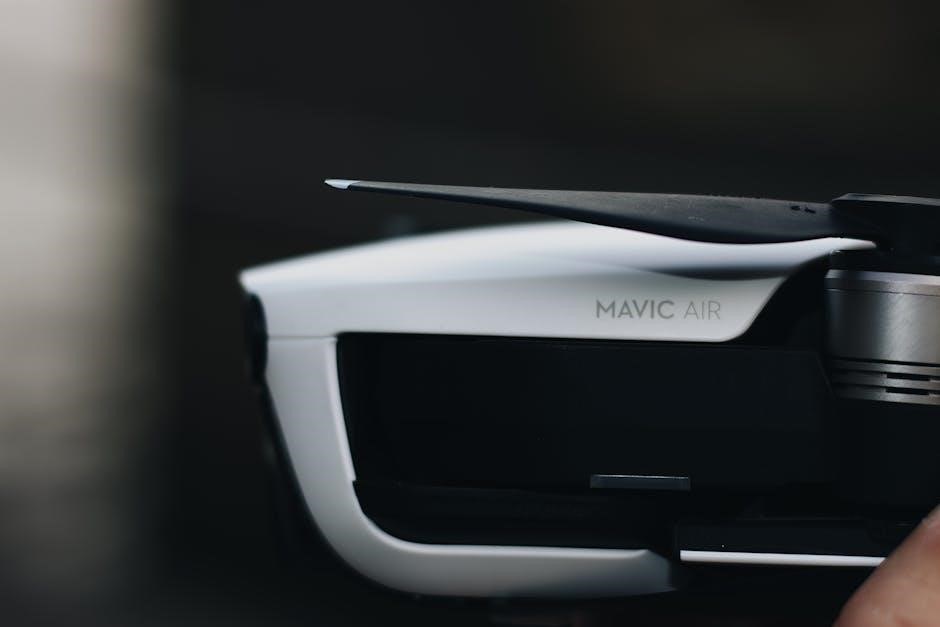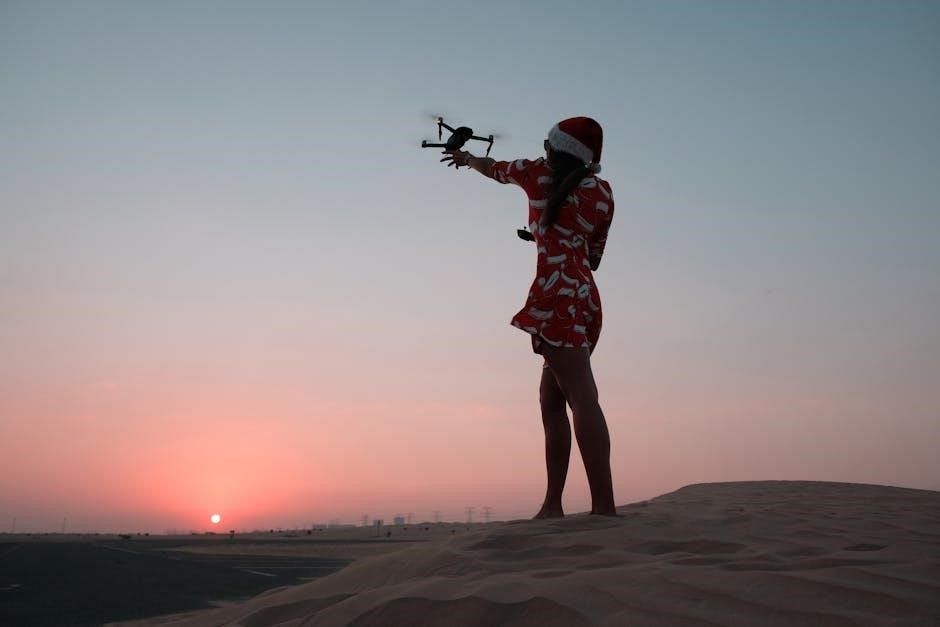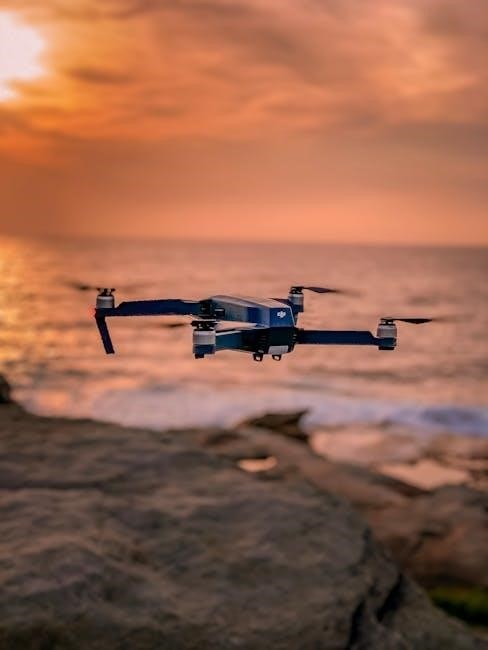Welcome to the Drone Pro Instructions manual, your comprehensive guide to safe and effective operation. This manual outlines key features, safety guidelines, and operational tips to ensure optimal performance and user satisfaction.
1.1 Overview of Drone Pro Features
The Drone Pro is equipped with advanced features such as high-definition cameras, GPS navigation, and intelligent flight modes. It offers stable flight performance, long battery life, and a user-friendly remote controller. The device supports headless mode, altitude hold, and customizable settings for enhanced control. Its compact design and durable construction ensure versatility for both recreational and professional use, making it a versatile tool for aerial photography and exploration.
1.2 Importance of Following Instructions
Adhering to the Drone Pro instructions is crucial for safety, proper operation, and preventing damage. Failure to follow guidelines may result in injury, equipment malfunction, or legal issues. Ensure all safety precautions, assembly steps, and flight regulations are strictly observed. This manual is designed to maximize performance and user experience while minimizing risks. Always read and understand the instructions before operating the Drone Pro.

Safety Precautions and Warnings
Always follow safety guidelines to prevent injuries and damage. Avoid flying near people or animals, and ensure the drone is not left unattended while charging. Adhere to age restrictions and operational warnings for safe and responsible use.
2.1 General Safety Guidelines
Always maintain a safe distance from people, animals, and obstacles. Ensure the drone is not left unattended while charging and avoid flying in prohibited areas. Follow age recommendations and keep the drone away from children. Never fly near airports or in bad weather. Check for local flight restrictions and ensure all pre-flight checks are completed before operation. Adhere to manufacturer guidelines for optimal safety.
2.2 Age Restrictions and Usage Limitations
The Drone Pro is not intended for children under 14 years of age and is classified as a complex device, not a toy. Use the drone responsibly and ensure adult supervision for younger users. Follow all local regulations regarding age and operational restrictions. Adhere to these guidelines to ensure safe and responsible operation of the device.

Technical Specifications of Drone Pro
The Drone Pro features a 43.6 Wh battery, 11.4 V voltage, and a maximum speed of 36 mph. It offers an 80-meter operating range and includes a 3-axis gimbal for stable footage.
3.1 Flight Performance and Capabilities
The Drone Pro excels with a top speed of 36 mph and a flight time of up to 34 minutes. Its omnidirectional Vision Systems enhance obstacle avoidance, ensuring smooth navigation. The 3-axis gimbal stabilizes the camera, capturing sharp footage even during high-speed maneuvers. With a range of 80 meters, it offers versatility for both recreational and professional use, delivering exceptional performance in various conditions.
3.2 Battery and Charging Specifications
The Drone Pro features a high-capacity battery with 43.6 Wh and 11.4 V, ensuring extended flight sessions. Charging requires 120 minutes using the provided adapter. Always monitor the charging process and avoid overheating. After charging, the battery may feel warm. Proper handling and storage are crucial for longevity. Follow all safety guidelines to maintain optimal performance and prevent damage.
Unboxing and Initial Setup
Welcome to the unboxing and initial setup guide for your Drone Pro. Carefully unpack and inspect all components, including the drone, remote controller, battery, and accessories. Follow the step-by-step instructions to ensure a safe and successful first flight experience.
4.1 Items Included in the Box
Upon unboxing, ensure all components are present: the Drone Pro, remote controller, one intelligent flight battery, a charger, power cable, four propellers, and a user manual. Additional items may include extra propeller guards, a gimbal clamp, and a carrying case. Verify each item for damage before proceeding with setup to ensure optimal functionality and safety.
4.2 Pre-Flight Checks and Preparations
- Ensure the battery is fully charged and properly secured in the drone.
- Inspect propellers for damage and ensure they are securely attached.
- Check the remote controller for proper functionality and pairing with the drone.
- Verify all firmware is up to date for optimal performance.
- Conduct a compass calibration and ensure the drone’s GPS is operational.
- Review weather conditions and ensure the area is clear of obstacles.
- Familiarize yourself with local flight regulations and restrictions.
Charging the Drone and Remote Controller
Connect the drone battery to the charger and plug it into a power outlet. Charge for 120 minutes. Avoid overcharging. Do not leave charging unattended.
5.1 Charging Procedures and Safety
Connect the drone battery to the charger and plug it into a power outlet. Charge for 120 minutes. Avoid overcharging. Do not leave charging unattended. The battery may be warm after charging. Ensure the remote controller is charged separately, typically requiring 3-4 hours. Always use original charging equipment to prevent damage or safety hazards. Follow all safety guidelines to ensure proper charging and operation.
5.2 Battery Maintenance Tips
To prolong battery life, store the drone battery at 50% charge in a cool, dry place. Avoid extreme temperatures and overcharging. Clean battery contacts regularly to ensure proper connection. Allow the battery to cool down after flight before recharging. Replace damaged or swollen batteries immediately. Follow these tips to maintain optimal performance and extend the lifespan of your Drone Pro battery.

Assembling and Calibrating the Drone
Unfold the arms and propellers, ensuring proper alignment. Follow the calibration steps in the manual for accurate flight performance and stable operation.
6.1 Step-by-Step Assembly Guide
Begin by unfolding the front arms, followed by the rear arms, ensuring proper alignment. Next, unfold all propeller blades, attaching them securely to the motors. Always unfold the front arms and propellers before the rear ones. Make sure all components are tightly secured and free from obstructions. Refer to the diagrams in the manual for precise assembly guidance.
6.2 Calibration Process for Accurate Flight
Place the drone on a flat, stable surface and ensure all arms are fully unfolded. Use the remote controller to initiate the calibration process by pressing and holding the designated buttons. Follow the on-screen prompts to complete the process. Ensure the drone is away from magnetic interference and level during calibration. After completion, test the drone’s stability and responsiveness to confirm accurate flight performance.

Understanding the Remote Controller
The remote controller is essential for precise drone operation, featuring joysticks, buttons, and a screen for real-time feedback. Learn its layout and functionality for seamless control.
7.1 Layout and Function of Controls
The remote controller features a intuitive layout with dual joysticks for directional control, buttons for mode switching, and a display screen for real-time flight data. The left stick controls altitude and yaw, while the right stick manages roll and pitch. Additional buttons activate features like Headless Mode, return-to-home, and camera settings. Ensure proper handling to maintain stable flight and avoid accidents.
7.2 Customizing Controller Settings
The remote controller allows customization to suit your flying style. Adjust stick sensitivity, button assignments, and mode preferences through the companion app or manual settings. Customize throttle, yaw, and pitch responses for precise control. Update firmware regularly for improved functionality. Experiment with settings to optimize performance and ensure a personalized flying experience tailored to your preferences and skill level.

Basic Flight Instructions
Master fundamental flight skills, including takeoff, landing, and navigation. Ensure arms and propellers are unfolded, maintain a safe distance from obstacles, and follow basic safety protocols;
8.1 Taking Off and Landing Safely
Ensure the drone is on a flat, obstacle-free surface. Turn on the drone and remote controller, then unfold all arms and propellers. Gently push the left joystick upward to ascend slowly. For landing, gradually lower the drone using the left joystick until it touches the ground. Avoid sudden movements and keep a safe distance from people and objects during both processes.
8.2 Navigating Basic Flight Modes
Drone Pro offers multiple flight modes for enhanced control. “Headless Mode” simplifies flying by ignoring the drone’s front and back orientation. Activate it using the designated button. Use the right joystick to navigate freely in any direction. “Starter Mode” limits speed for beginners. Always practice in open spaces and avoid obstacles for safe and enjoyable flights. Familiarize yourself with each mode to master your flying experience.

Advanced Flight Features
Explore intelligent modes like O3 transmission for HD live view and omnidirectional obstacle sensing. These features enable precise navigation and stable footage capture, enhancing your flight experience.
9.1 Exploring Intelligent Flight Modes
Drone Pro offers advanced intelligent flight modes like ActiveTrack, Waypoints, and Follow Me. These modes enable autonomous flight, obstacle avoidance, and precise navigation. Utilize the 3-axis gimbal for stable footage and explore features like O3 transmission for HD live view. These modes enhance creativity and operational efficiency, ensuring a seamless and professional flying experience for users of all skill levels.
9.2 Using Headless Mode and Other Special Features
Activate Headless Mode by pressing the designated button, allowing the drone to fly relative to your position; This mode simplifies control, making flight direction independent of the drone’s orientation. Additional features like one-key return and gesture control enhance usability. These special modes are designed to make flying intuitive and enjoyable, catering to both novice and experienced pilots for versatile and creative flight experiences.
Camera and Gimbal Operation
The Drone Pro features a high-quality camera and 3-axis gimbal for stable footage. Capture sharp photos and videos with ease, adjusting settings for optimal results in various lighting conditions.
10.1 Capturing High-Quality Photos and Videos
To capture high-quality photos and videos, ensure the camera settings are optimized. Use the gimbal to stabilize footage, reducing blur and vibrations. Adjust exposure and focus for clarity. Shoot in RAW for better editing capabilities. Utilize intelligent modes like tracking or panorama for dynamic shots. Always calibrate the gimbal before flights for optimal performance and stability during aerial photography sessions.
10.2 Adjusting Gimbal Settings for Stability
Calibrate the gimbal before each flight for optimal stability. Use the remote controller to adjust pitch, roll, and yaw. Ensure the camera is level and balanced. Enable stabilization modes in the settings to minimize vibrations. Regularly check and tighten gimbal screws to prevent looseness during flight. Proper adjustment ensures smooth footage and enhances overall camera performance during aerial operations and photography sessions.

Maintenance and Troubleshooting
Regularly inspect and clean the drone’s components, check for wear and tear, and ensure all software is up-to-date. Address issues promptly to maintain performance and safety.
11.1 Regular Maintenance Tasks
Perform routine checks on propellers, motors, and battery health. Clean debris from the drone and gimbal. Update firmware regularly and store batteries properly when not in use. Inspect for wear and tear, ensuring all components are secure. Regular maintenance ensures optimal performance, prevents malfunctions, and extends the lifespan of your drone. Follow the manual for detailed procedures.
11.2 Common Issues and Solutions
Address issues like battery drain by ensuring proper charging and storage. For connectivity problems, reset the drone and remote controller. Propeller imbalance can cause unstable flight; replace worn propellers. Firmware errors require updates or reinstallation. Consult the manual or support resources for troubleshooting guides to resolve these common issues effectively and maintain smooth operation.

Legal and Regulatory Considerations
Ensure compliance with local drone regulations, including flight restrictions and age requirements. Register your drone if mandated and always respect privacy laws during operation.
12.1 Understanding Flight Restrictions
Drone operations are subject to various legal restrictions, including altitude limits, no-fly zones near airports, and prohibited areas like national parks or military bases. Always check local regulations before flying. Ensure compliance with FAA guidelines, such as maintaining line-of-sight and avoiding flights over crowded areas or sensitive infrastructure. Respect privacy laws and adhere to age restrictions for pilots.
12.2 Registering Your Drone (If Required)
In many regions, drones weighing over 250 grams require registration with aviation authorities like the FAA. This process typically involves creating an account, paying a fee, and labeling your drone with a unique ID. Failure to register can result in penalties. Ensure compliance with local regulations and update your registration as required to maintain legal drone operation.
Thank you for completing the Drone Pro Instructions manual. For further assistance, visit the official DJI website or download the DJI GO app for tutorials and support.
13.1 Summary of Key Instructions
Always follow safety guidelines, complete pre-flight checks, and understand flight modes before operating. Ensure proper assembly, calibration, and battery maintenance. Refer to the manual for troubleshooting and additional resources. Adhere to legal restrictions and register your drone if required. Practice responsible flying to ensure safe and enjoyable experiences with your Drone Pro.
13.2 Where to Find Additional Support and Manuals
For further assistance, visit the official DJI website or download the DJI GO app. Explore the Download Center for user manuals, firmware updates, and tutorial videos. Contact customer support for personalized help. Additional resources, including FAQs and troubleshooting guides, are available in the manual or online forums dedicated to drone enthusiasts.




